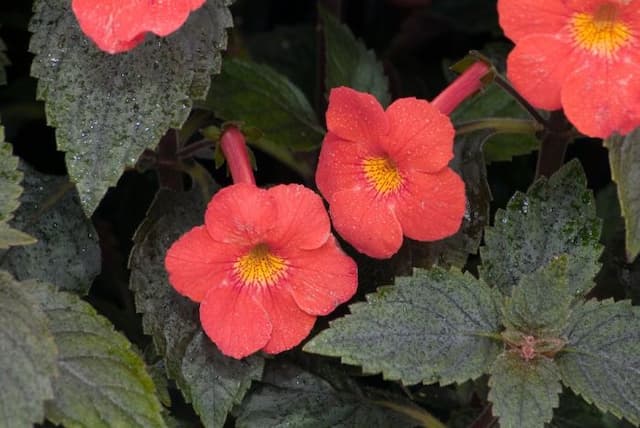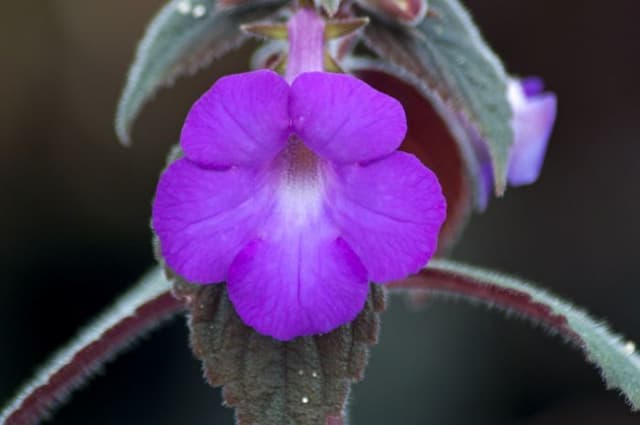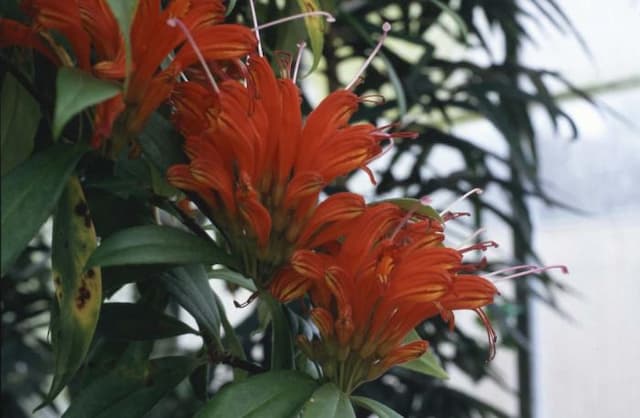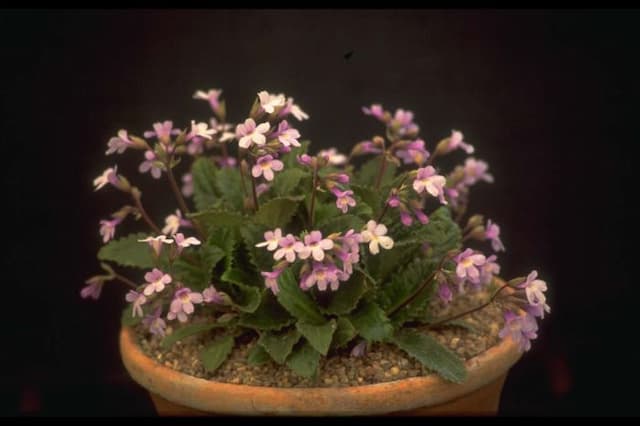Cape Primrose Streptocarpus 'Charlotte'

ABOUT
Streptocarpus 'Charlotte' is a plant with an attractive appearance, primarily grown for its beautiful flowers and foliage. The plant showcases an abundant display of delicate trumpet-shaped blooms that exhibit a shade of purple with distinctive throat markings in a contrasting yellow or white, giving it a striking appearance. The leaves of 'Charlotte' are lush, elongated, and velvety, emerging in a rosette-like formation from the base of the plant. These leaves are typically a deep green, which creates a pleasing contrast to the vibrant flowers. The blooms are known for their extended flowering season, adding lasting color and interest to indoor spaces where the plant is commonly displayed. The overall presentation of Streptocarpus 'Charlotte' is one of elegance and charm, with its showy flowers and rich greenery making it a popular choice for plant enthusiasts.
About this plant
 Names
NamesFamily
Gesneriaceae.
Synonyms
Cape Primrose, African Violet.
Common names
Streptocarpus 'Charlotte'.
 Toxicity
ToxicityTo humans
Cape Primrose (Streptocarpus 'Charlotte') is not known to be toxic to humans. However, as with any non-food plant, caution is advised since individual allergies and reactions can occur. Ingesting plant parts is not recommended, and if any adverse reactions are observed after handling or accidental ingestion, it is best to consult with a medical professional.
To pets
Cape Primrose (Streptocarpus 'Charlotte') is also not known to be toxic to pets. It is generally considered safe around pets, including cats and dogs. However, ingestion of the plant can potentially cause mild gastrointestinal upset in some animals. If you notice any signs of distress in your pet after ingestion, such as vomiting or diarrhea, it is advisable to contact your veterinarian.
 Characteristics
CharacteristicsLife cycle
Perennials
Foliage type
Evergreen
Color of leaves
Green
Flower color
Blue
Height
1 foot (30 cm)
Spread
1 foot (30 cm)
Plant type
Herb
Hardiness zones
10
Native area
Africa
Benefits
 General Benefits
General Benefits- Decorative Appeal: Streptocarpus 'Charlotte', also known as Cape Primrose, has attractive blooms and foliage that add aesthetic value to home or garden.
- Long Blooming Period: Cape Primrose can bloom for most of the year with proper care, providing extended visual interest.
- Low Maintenance: It requires minimal care, making it suitable for busy individuals or those new to gardening.
- Variety of Colors: Comes in various vibrant colors that can complement any decorating scheme or garden palette.
- Compact Size: Its small stature makes it ideal for windowsills, desks, and other small spaces.
- Indoor and Outdoor Use: Can be grown inside as a houseplant or outside in suitable climates, offering versatility for gardeners.
- Non-Toxic: Cape Primrose is non-toxic to humans and pets, making it a safe choice for households.
 Medical Properties
Medical PropertiesThis plant is not used for medical purposes.
 Air-purifying Qualities
Air-purifying QualitiesThis plant is not specifically known for air purifying qualities.
 Other Uses
Other Uses- Photographic Subject: The Streptocarpus 'Charlotte', also known as Cape Primrose, can be used as an attractive subject for macro photography due to its detailed and delicate flowers.
- Artistic Inspiration: Artists can draw inspiration from the intricate patterns and vibrant colors of Cape Primrose flowers for paintings, illustrations, and textile designs.
- Educational Tool: Biology teachers may use Streptocarpus 'Charlotte' to demonstrate plant anatomy and pollination processes to students.
- Wedding Decor: The elegant flowers of Cape Primrose can be incorporated into wedding bouquets or table arrangements for a unique botanical touch.
- Gift Plant: Potted Streptocarpus 'Charlotte' makes a thoughtful gift for plant enthusiasts or as a housewarming present.
- Collectibles: Plant collectors may include the Cape Primrose in their collection for its unique characteristics and variety among Streptocarpus species.
- Color Themes: Its flowers can be used to establish a color theme in interior design or event planning, complementing fabrics, and other decorative items.
- Greeting Cards: The image of Streptocarpus 'Charlotte' can be featured on greeting cards for various occasions such as birthdays, Mother's Day, or as a thank-you note.
- Therapeutic Horticulture: Growing and caring for Streptocarpus 'Charlotte' can provide a therapeutic hobby for individuals seeking relaxation and stress relief.
- Ice Cubes: Petals of the Cape Primrose can be frozen into ice cubes to add an elegant and edible floral touch to summer beverages.
Interesting Facts
 Feng Shui
Feng ShuiThe Cape Primrose is not used in Feng Shui practice.
 Zodiac Sign Compitability
Zodiac Sign CompitabilityThe Cape Primrose is not used in astrology practice.
 Plant Symbolism
Plant Symbolism- Endurance and Longevity: Streptocarpus, also known as Cape Primrose, often symbolizes enduring life and longevity due to its ability to bloom for a long period.
- Hope and Rebirth: With its bright flowers and continuous bloom cycle, Cape Primrose may represent hope and the concept of rebirth or the start of something new.
- Adaptability: Cape Primrose can grow in varied conditions with different levels of light and temperature, signifying adaptability and resilience in various environments or situations.
- Patience: Requiring patience for optimal care and blooming, Cape Primrose embodies the idea of patience in growth and development.
 Water
WaterCape Primrose should be watered when the top inch of soil feels dry to the touch, generally every 7 to 10 days depending on the humidity and temperature of your environment. Apply water gently at the base of the plant until it starts to drain from the bottom, indicating that the soil is thoroughly moistened. A rough estimate would be to give it around 8 to 16 ounces of water for a standard 6-inch pot. Be cautious not to over-water as the plant dislikes soggy soil. During the winter, reduce watering slightly as the plant requires less moisture.
 Light
LightCape Primrose thrives in bright, indirect sunlight. The ideal spot would be near an east-facing window where it gets gentle morning sun but is shielded from the harsh afternoon rays. If placed in too much direct sun, the leaves can become scorched. Conversely, insufficient light can lead to poor flowering, so finding that balance is key.
 Temperature
TemperatureCape Primrose prefers an environment with temperatures ranging from 60 to 75 degrees Fahrenheit. They can survive short periods outside this range, but prolonged exposure to temperatures below 50 degrees Fahrenheit or above 80 degrees Fahrenheit can be harmful. The ideal growing conditions for this plant are consistently maintained temperatures within the preferred range, avoiding cold drafts and sudden temperature changes.
 Pruning
PruningTo encourage robust growth and flowering in Cape Primrose, it's essential to prune spent flowers and remove any dead or yellowing leaves. Pruning should be done as needed throughout the year, particularly after a bloom cycle, to promote the next wave of flowers. The best time for significant pruning is in the late winter or early spring before the plant begins its active growth phase.
 Cleaning
CleaningAs needed
 Soil
SoilThe best soil mix for Cape Primrose is a light, fast-draining mix, such as a combination of peat, perlite, and vermiculite. The ideal soil pH for Cape Primrose should be slightly acidic to neutral, around 6.0 to 7.0.
 Repotting
RepottingCape Primrose should be repotted annually or when it outgrows its pot, ideally in the spring or summer during their active growing period.
 Humidity & Misting
Humidity & MistingCape Primrose thrives in moderate to high humidity, around 50% to 60%, which can be maintained with regular misting or a humidity tray.
 Suitable locations
Suitable locationsIndoor
Provide bright, indirect light and keep soil moist.
Outdoor
Shelter from strong sun; place in partial shade.
Hardiness zone
10-11 USDA
 Life cycle
Life cycleStreptocarpus 'Charlotte', also known as Cape Primrose, begins its life cycle when seeds are sown in a well-draining soil mix and lightly covered, requiring warmth and light for germination. Once the seedlings emerge, they enter the vegetative stage, developing a rosette of leaves and slowly maturing over several months. During this time, it is important for them to receive bright, indirect light and consistent moisture. As the plant matures, it initiates the flowering stage, producing trumpet-shaped flowers that can bloom almost continuously if the spent flowers are regularly removed and the plant is well-cared for. After the flowering phase, if the conditions remain favorable, the plant can enter a rest period where growth slows, and reduced watering is necessary. Lastly, the plant can be propagated through leaf cuttings or division, extending its life cycle through new plants while the parent plant eventually ages and declines.
 Propogation
PropogationPropogation time
Spring-Early Summer
Propogation: Streptocarpus 'Charlotte', commonly known as Cape Primrose, can be propagated through leaf cuttings, which is the most popular method due to its simplicity and effectiveness. Propagation typically takes place in the spring, when the plant's growth is most vigorous. A healthy, mature leaf is selected and cut across the width into sections, ensuring each section has a vein. These sections are then placed in a well-draining potting mix and lightly covered with soil. The potting mix is kept evenly moist, and in a warm environment with indirect sunlight. Roots and new shoots will usually develop within a few weeks, after which they can eventually be transplanted into individual pots. This method utilizes the plant's natural ability to regenerate from leaf tissue, making it an accessible technique for gardeners to multiply their Cape Primrose collection.









